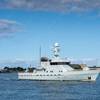NTSB Cites Potential Fire Risks for Marine Operators Carrying Scrap Materials
Lithium-ion batteries and other possible ignition sources could pose a fire safety issue in the transportation of scrap materials as cargo, the National Transportation Safety Board (NTSB) said Thursday.
Although scrap metal cargo is typically nonhazardous and poses a low fire risk, there have been several recent fires involving such cargo. In January 2022, a shoreside pile caught fire in Newark, N.J. Two international vessels carrying scrap material experienced cargo fires in 2022 and in 2017 the Japan Transport Safety Board investigated a scrap metal fire in a vessel’s cargo hold in Fukuoka City, Japan.
On May 23, 2022, the towing vessel Daisy Mae was towing a loaded scrap metal barge northbound in Delaware Bay when fire was discovered on board the barge. The fire burned for 26 hours before it was extinguished by responding fire boats. No injuries or pollution were reported. Damage to the barge was estimated at $7 million.
In a report released Thursday, the NTSB determined the probable cause of the fire was the ignition of a combustible material by an undetermined source, such as sparking from shifting metallic cargo, self-heating of metallic or nonmetallic cargo, improperly prepared vehicles and appliances or damaged lithium-ion batteries.
Even with supplier acceptance agreements and quality assurance personnel visually inspecting scrap metal, metallic and nonmetallic hazardous materials are often present within shoreside scrap metal piles and could inadvertently be loaded onto vessels. These often-flammable materials elevate the fire risk and can lead to intense fires. Once scrap metal is loaded onto a barge, it is difficult for a towing vessel crew to visually inspect the cargo while underway.
To minimize the risk of fire, qualified cargo-surveying personnel can assist the vessel’s captain before and during loading operations to limit the presence of hazardous, combustible material in scrap metal. Thermal imagery is also an effective tool in identifying hot spots in scrap metal cargo at shoreside facilities.













